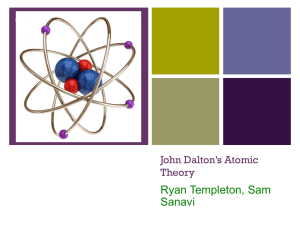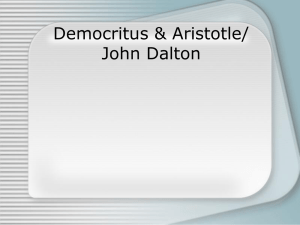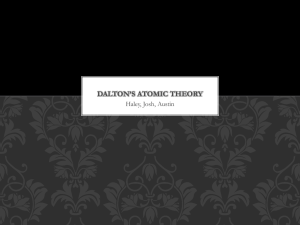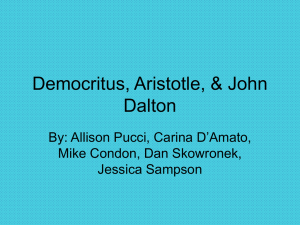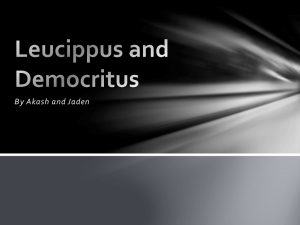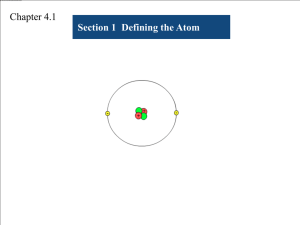Dalton`s theory of atoms
advertisement
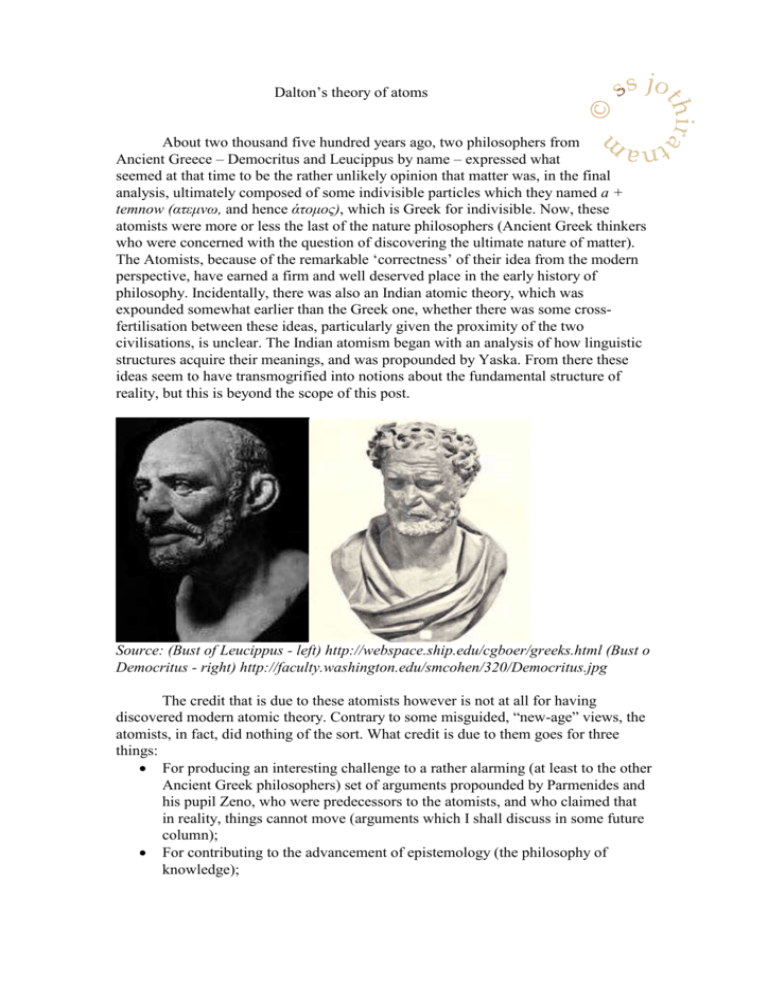
Dalton’s theory of atoms About two thousand five hundred years ago, two philosophers from Ancient Greece – Democritus and Leucippus by name – expressed what seemed at that time to be the rather unlikely opinion that matter was, in the final analysis, ultimately composed of some indivisible particles which they named a + temnow (ατεμνω, and hence άτομος), which is Greek for indivisible. Now, these atomists were more or less the last of the nature philosophers (Ancient Greek thinkers who were concerned with the question of discovering the ultimate nature of matter). The Atomists, because of the remarkable ‘correctness’ of their idea from the modern perspective, have earned a firm and well deserved place in the early history of philosophy. Incidentally, there was also an Indian atomic theory, which was expounded somewhat earlier than the Greek one, whether there was some crossfertilisation between these ideas, particularly given the proximity of the two civilisations, is unclear. The Indian atomism began with an analysis of how linguistic structures acquire their meanings, and was propounded by Yaska. From there these ideas seem to have transmogrified into notions about the fundamental structure of reality, but this is beyond the scope of this post. Source: (Bust of Leucippus - left) http://webspace.ship.edu/cgboer/greeks.html (Bust o Democritus - right) http://faculty.washington.edu/smcohen/320/Democritus.jpg The credit that is due to these atomists however is not at all for having discovered modern atomic theory. Contrary to some misguided, “new-age” views, the atomists, in fact, did nothing of the sort. What credit is due to them goes for three things: For producing an interesting challenge to a rather alarming (at least to the other Ancient Greek philosophers) set of arguments propounded by Parmenides and his pupil Zeno, who were predecessors to the atomists, and who claimed that in reality, things cannot move (arguments which I shall discuss in some future column); For contributing to the advancement of epistemology (the philosophy of knowledge); And for adducing some remarkably modern notions of how the world works, by reasoning in a logical manner from a set of assumptions that, in a sense, simply happened to be right. Another remarkable aspect of the ideas propounded by the Atomists was how close they were in many ways to modern atomic theory. According to them: 1. atoms are indivisible (in fact, we now know that this is not true, but we also know that if we divide an atom of say uranium, the remnants are no longer uranium, but some other element say caesium and rubidium for example); 2. there are many different kinds of atoms, each with a distinct size and shape (again, in a way this parallels our modern understanding of atoms); 3. they are in constant motion (ditto); 4. they are invisible, being far too small to be detected by human senses (ditto); 5. they can combine and un-combine in a variety of ways, and do so by ‘hooking’ together, or by ‘unhooking’. When they hook together, they make the macroscopic things which we see: growth is the result of atoms hooking together, and decay is the reverse process: atoms unhooking (ditto); 6. there are only atoms and void (kind of ditto, except that there are also the 4 fundamental forces of nature, and depending on your affiliation, strings, membranes, and a bizarre zoo of other entities out there); The atomists’ ideas, needless to say, both when they were first propounded and even now, were / are so contrary to most people’s everyday experience, that throughout most of recorded history their ideas did not find wide acceptance. After all, there are very few macroscopic experiences that clearly and unequivocally indicate the discrete, particulate nature of matter, unless you know how to interpret them. Anyway, even though unconvincing, the atomists theory, as well as their explanations of many physical phenomena were so elegant that scholars continued to preserve their ideas, and to transmit them to future generations. Eventually, in the early nineteenth century, John Dalton, (1766-1844) a colour-blind English scientist and school teacher whose only recreation appears to have been lawn bowling on Thursday afternoons, hit on the same idea, viz., that matter must be discrete in nature. In honour of Leucippus and Democritus, from whom he derived his inspired solution to the question what are things made of (and no small thanks to an education grounded in the classics), Dalton named the fundamental constituents of matter atoms. Source: http://reichchemistry.wikispaces.com/A.+Grimner+and+J.+Condlin+Time+Line+Project At this point, you may be wondering what, if anything, distinguished Dalton’s conjecture of the atomic nature of matter, from the seemingly identical conclusion of the atomists’. Well, the difference, and it’s an enormous one, is that Dalton backed up his conjectures with some experimental evidence, and with some arguments which were premised on empirical observations. This speaks to the heart of science. The theories in science are backed up by empirical evidence. This is a far cry from claims which are made on the basis of metaphysical or other appeals. Thus, for example, there is good, empirical reason to accept Darwinian evolution, but no scientific reasons for accepting biblical an explanation of how life came to be. Not that Dalton was entirely right or anything – in fact he was very wrong on one important point, like the Greek Atomists, he too believed that atoms were indivisible, and had no internal structure, when in fact, we now know to the contrary that they do, and that they in their turn are composed of even more fundamental particles. However, Dalton did lay out the essential foundations of modern atomic theory: Firstly, Dalton argued that each element was composed of tiny pieces of matter which he called atoms, and which, for a given element, were all identical in every way, and which could not be further subdivided without destroying the element at hand. An iron atom in other words is the smallest piece of iron that you can have. Indeed, this is the very notion of an element: a chemically elementary particle, a material which cannot be further decomposed or transformed into another material using chemical means. In fact, the concept of elements too (stoicheia), like that of atoms, comes from the ancient Greeks. Secondly, according to Dalton, the atoms of each element were different from those of any other element, and it was various aspects of these differences that accounted for the differing properties of the elements. Hence, gold is a dense yellow relatively non-reactive metal, while chlorine is a yellowish-green highly reactive gas because the respective atoms of gold and chlorine have different properties. Thirdly, he suggested that all compounds were composed of some combination of atoms of more than one element. The ultimate unit of table salt for example is the sodium chloride molecule, which is always composed of one sodium atom chemically joined to one chlorine atom. Fourthly, he maintained that just as the elements derived their properties from the characteristics of their constituent atoms, so also did compounds get their properties from specific combinations of different elemental atoms (methane (CH4) and butane (C4H10) for example are both compounds composed of the elements carbon and hydrogen, but methane and butane have different properties because of their different ways in which carbon and hydrogen have been combined in these two compounds). Fifthly, he showed that the elements in a compound are always combined in simple ratios (1:1, 2:5, 34:56, etc.). This in fact was the clincher for Dalton’s theory. If compounds are always composed of simple ratios of elements, then it necessarily follows that the ultimate constituents of matter must be discrete, as otherwise some fraction of an atom could add itself to some other fraction of some other atom. What Dalton found however was that the constituents of the many specific compounds which he investigated were always present in fixed ratios. Thus, he reasoned, matter must ultimately be composed of minute indivisible particles. Finally, Dalton contended that atoms cannot be created or destroyed, and that by extension, all chemical changes were merely separations, combinations or rearrangements of atoms. These were the basic laws of chemical behaviour that Dalton came up with, based on his atomic hypothesis. They revolutionized people’s understanding of the chemical behaviours of substances. Even though people knew about chemical processes, Dalton’s work afforded them a fresh and convincing theoretical understanding of the phenomena which they had been familiar with, in some cases (as with the manufacture of glass, iron, or alcohol say) for millennia. Dalton’s thinking also eventually spurred other scientists to do further thinking about atoms, and the ultimate nature of matter, and in turn to come up with the stream of discoveries that together constitutes atomic physics, but that is a story for another day.
